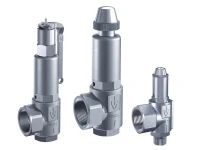- What is an air actuated H2 valve?
- What is the working principle of an air actuated hydrogen valve?
- Where is this type of hydrogen valve used?
- What are the key performance criteria of air actuated H2 valves?
- Why are such air actuated hydrogen valves important components?
- What are the technical requirements for the attached connections/fittings?
- Which materials are used for air actuated hydrogen valves?
- In which environments can such valves operate?
- Which testing procedures are used to ensure high-quality manufacturing standards for air actuated hydrogen valves?
Browse all valves, including air actuated hydrogen valves from leading suppliers on our marketplace!
What is an air actuated H2 valve?
An air actuated valve is generally designed as the on/off needle valve type. The actuation is done pneumatically which allows for the use of these valves in automated control PLC circuits. This type of pneumatically actuated hydrogen valve is either of the “normally closed” (air to open) or of the “normally open” (air to close) type.
What is the working principle of an air actuated hydrogen valve?
The air actuated valve for hydrogen applications works with a pressure ratio where low pressure shop air is used on a large air piston to generate the closing, or opening force, respectively, to operate the valve stem.
Where is this type of hydrogen valve used?
In hydrogen refilling stations, such valves are used from the pressure generation (compressor) module downstream to the pressure vessels for the control of the so-called filling banks. Furthermore, these hydrogen valves are used inside the H2 fuel dispenser.
They are used for the shut-off at the compressor, control of the vessel cascade system (pressure banks) and shut-off for the dispenser filling hoses as well as for the release of the pressure after the filling process is completed.
Another application is the qualification testing and end-of-line testing for e.g. composite cylinders, TPRDs and other accessories used in a fuel cell vehicle.
What are the key performance criteria of air actuated H2 valves?
Internal leakage of seat/stem as well as external leakage over seal must be bubble tight. Fulfilling the requirements of the ISO 19880-3 and ANSI/SAE HGV 4.7 standards is desirable for manufacturers of air actuated valves. The minimum and maximum operating temperature of these valves are defined according to the same standards. The materials of construction need to be selected to minimize the risk of hydrogen embrittlement and to ensure the lifelong full range of functionality. The valves are marked with an EX-sign and are in conformity with Group II Category 2G/2D Explosion group IIC constructive safety.
Why are such air actuated hydrogen valves important components?
The valves are needed to control the filling process. From the moment the quick coupling at the dispenser is connected, throughout the filling cycle, until the storage cylinder has reached the final pressure, the hydrogen valve is opening and closing multiple times for a safe and efficient filling process in compliance with the SAE filling protocol.
What are the technical requirements for the attached connections/fittings?
Coned and threaded connections are the proven connection type for any high-pressure hydrogen application. These connections are sealing metal-to-metal and are safe because of the low axial forces caused by the pressure. Weep holes help to identify any occurring leaks at an early stage. For applications with equipment subjected to vibration, anti-vibration assemblies are an optional choice to enhance safety.
Which materials are used for air actuated hydrogen valves?
To minimize the risk of hydrogen embrittlement, 1.4404 (stainless steel 316L) is used as body material, while 1.4980 (A286) is used for the valve stem for reasons of enhanced durability. Air actuated valves are specially cleaned and designed with hydrogen compatible seals. Compared to conventional packing designs, the lifetime of the special seal design with respect to opening and closing cycles is much longer. Lubricants are selected especially for hydrogen applications to prevent chemical reactions with the media.
In which environments can such valves operate?
The air actuated valve to facilitate dispensing of hydrogen fuel at a hydrogen refilling station must be specifically designed for use in very challenging environmental conditions. pneumatically activated hydrogen valves are located inside the fuel dispenser and are subject to severe environmental impact, such as huge temperature changes, salt spray, and ammonia emissions. This applies similarly to hydrogen valves located on the hydrogen filling station compressor, and thus subjected to elevated levels of vibration.
Which testing procedures are used to ensure high-quality manufacturing standards for air actuated hydrogen valves?
An air actuated hydrogen valve passes a 100% leak test using helium, testing is carried out for internal and external leakage. These valves are subject to the qualification process to meet the requirements of the ISO 19880-3. A special test stand for the qualification testing was engineered and built and will be used with 100% hydrogen gas in combination with an integrated climate chamber.
Content contributed by Maximator GmbH
As an internationally leading company specialized in high-pressure technology, Maximator develops high-performance products and solutions for a variety of uses and applications in the field of high pressure testing and production equipment, hydraulics and pneumatics. Maximator has many years of experience with components, power units and test systems especially for hydrogen applications Many components for the development of this future technology are exposed to extreme stresses. Maximator meets this challenge with innovative high pressure test technology for hydrogen components such as valves, pipes or CGH vessels. We can carry out all legally prescribed testing on pressure bearing components with our test technology: from individual acceptance to type approval testing. We also offer gas control technology for hydrogen applications – approved effective and reliable technology for automotive manufacturers and suppliers.
Last update: 15.1.2023












